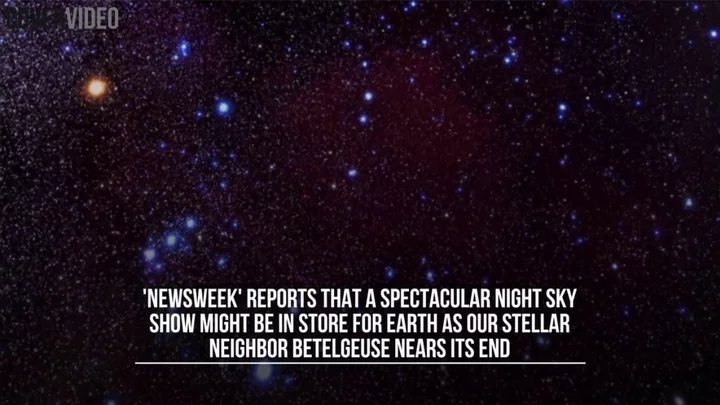
Scientists uncover supergiant ’space ghost’ in night sky
Scientists have been studying a “space ghost” which could be due to explode in just a few decades, changing the night sky forever – if it hasn’t already, that is. The object in question is a large star called Betelgeuse and the scientific community is divided over whether or not it’s already become a supernova. One theory states that the light from Betelgeuse takes so long to reach Earth it could mean the huge explosion has already taken place. Betelgeuse has been a supergiant red star for an estimated 40,000 years, but that could change relatively soon. Sign up to our free Indy100 weekly newsletter Michael Shara is the curator of astrophysics at the American Museum of Natural History. He told the US Sun: "Betelgeuse lies somewhere between about 450 and 550 light years from Earth." He went on to say: "Betelgeuse’s position appears to change slightly, as seen from Earth, between June and December, when the Earth is on opposite sides of its orbit around the Sun. "That tiny change in position is a direct measure of the distance to Betelgeuse." He went on to expand on the theory by saying: "Let's assume that Betelgeuse is precisely 500 light years distant. "If Betelgeuse exploded as a supernova anytime in the past 499 years, the light from that event has not yet had enough time to reach Earth…so we have no way of knowing if Betelgeuse has already blown up. "If, for example, Betelgeuse blew up in 1600 AD, we won’t know about it until the year 2100. But if it blew up on August 1, 1523, then on August 1, 2023 it will become about as bright as the full Moon. "The only naked eye supernova of the past century occurred in 1987… all astronomers would be thrilled and delighted if Betelgeuse (or another dying star) graced our night sky with a supernova in the coming decades." Have your say in our news democracy. Click the upvote icon at the top of the page to help raise this article through the indy100 rankings.
2023-07-14 20:26

India’s Third Moon Mission Lifts Off as Space Race Intensifies
India launched an uncrewed mission to the lunar surface, joining the US, China and others in a new
2023-07-14 17:47

Doctors reattach boy's head after suffering 'internal decapitation'
Doctors have performed a minor miracle after re-attaching a “'decapitated” boy’s head after he was hit by a car. The miraculous surgery occurred after Suleiman Hassan, a Palestinian boy from the West Bank, was severely injured after being hit by a car while out riding his bike. He was airlifted to Hadassah Ein Kerem’s Trauma Unit in Jerusalem and went straight to surgery. He suffered what is known as an internal decapitation – this occurs when the base of the skull and top of the spine become detached by the skin remains intact. This extremely rare injury can occur when a strong, sudden impact on the head results in the muscles and ligaments that hold the head in place to sever, accounting for less than one per cent of spinal injuries. Sign up to our free Indy100 weekly newsletter Doctors explained that Hassan’s head was “'almost completely detached from the base of his neck” before he underwent painstaking surgery taking several hours. The procedure involves reattaching the skull and spinal column using technology such as screws, rods, plates and bone grafts. One of the surgeons who operated on Hassan, Dr Ohad Einav, told The Times of Isreal: “We fought for the boy’s life.” Dr Einav continued: “The procedure itself is very complicated and took several hours. While in the operating room, we used new plates and fixations in the damaged area… “Our ability to save the child was thanks to our knowledge and the most innovative technology in the operating room.” Surgeries such as the one that saved Hassan’s life are only possible if internal decapitation victims have their major blood vessels intact, keeping the brain alive. Hassan’s surgery took place in June but has only recently been made public as the boy continues to recover at home with rehabilitation. Miraculously, Hassan can walk unaided and has no neurological problems following the shocking injury. Have your say in our news democracy. Click the upvote icon at the top of the page to help raise this article through the indy100 rankings.
2023-07-14 16:51

Satellite Firm Viasat Stock Falls After ‘Unexpected’ Deployment Event
Viasat Inc. shares fell as much as 36% Thursday, on track for a record drop if losses hold,
2023-07-13 22:28

Google is excellently trolling Flat Earthers
Oh Google, you naughty old devil. Someone in Silicone Valley is rolling around in laughter after pulling off this hilarious prank at the expense of the Flat Earth community. Flat Earthers believe that the world is flat, and that any evidence to the contrary is faked. Their belief that the world is flat has been described as the ultimate conspiracy theory, as they also think that several governments and NASA are working together to keep the general public in the dark. Sign up to our free Indy100 weekly newsletter Now, one member of Google's workforce has decided to take matters into their own hands with this subtle but oh-so-effective troll. Log onto Google, and access Google Translate. When you're in there, type in 'I'm a flat-earther' in English, then look at the French translation. If you're not a fluent French speaker, then the translation might need explaining. Try flipping that box around again and see what you get. In other flat earthers news, they announced that they think that Australia - yes, that massive, dusty continent that's given us Kylie Minogue, and has a population of 24 million - doesn't exist. In a now-deleted Facebook post, one of the leaders of the movement Shelley Floryd wrote: Australia does not exist. All things you call 'proof' are actually well-fabricated lies and documents made by the leading governments of the world. Your Australian friends? They're all actors and computer-generated personas, part of the plot to trick the world. If you think you've ever been to Australia, you're terribly wrong. The pilots are all in on this and have in all actuality only flown you to islands close nearby - or in some cases, parts of South America, where they have cleared space and hired actors to act our as real Australians. As if that wasn't enough, they also said that they think that gravity doesn't exist and that the only real force is electromagnetism. Right... Now we see why Google set up the troll. Have your say in our news democracy. Click the upvote icon at the top of the page to help raise this article through the indy100 rankings.
2023-07-13 19:50

Nasa shares spectacular never-before-seen images of stars 'being born'
Nasa are celebrating the first birthday of the James Webb Space Telescope by releasing extraordinary images of stars 'being born'. In the images, which almost look surreal, rainbow bursts with tiny twinkles can be seen. "The darkest areas are the densest, where thick dust cocoons still-forming protostars", the space giants say. "These occur when a star first bursts through its natal envelope of cosmic dust, shooting out a pair of opposing jets into space like a newborn first stretching her arms out into the world." Click here to sign up for our newsletters
2023-07-13 18:57

‘Diverse organic matter’ found on Mars by Nasa rover
Diverse types of organic molecules have been found on Mars by a Nasa rover. The material was detected by the Perseverance rover in the Jezero Crater on Mars, scientists said. Researchers are unable to rule out that the materials have a “biotic” origin, or are the result of life on the planet. But they might also be formed in other ways, such as interactions between water and dust or having been dropped onto the planet by dust or meteors. The findings suggest that Mars may have had a far more active past than we realised – and could have significant implications for the search for alien life. According to the study, understanding more about Martian organic matter could shed light on the availability of carbon sources, with implications for the search for potential signs of life. The Scanning Habitable Environments with Raman and Luminescence for Organics and Chemicals (Sherloc) instrument on the rover is the first tool to enable fine-scale mapping and analysis of organic molecules and minerals on Mars. Perseverance landed within the Jezero crater, the site of an ancient lake basin with high potential for past habitability, in February 2021. Since then scientists have been exploring the geological make-up of the crater floor using a suite of tools on board the rover that can take pictures of and analyse the rocks. Sunanda Sharma, Ryan Roppel and their colleagues analysed observations from two formations on the Jezero crater floor. Signals of organic molecules were detected on all 10 targets that Sherloc observed in the Jezero crater floor, concentrated in the Maaz formation, more than in the Seitah formation. The data showed diverse mineral association and spatial distribution that may be unique to each formation. The researchers suggest the diversity among these observations may provide insight into different ways that organic matter may have originated: potentially through deposition by water, or in combination with volcanic materials. Writing in the Nature journal, the authors said: “Our findings suggest there may be a diversity of aromatic molecules prevalent on the Martian surface, and these materials persist despite exposure to surface conditions. “These potential organic molecules are largely found within minerals linked to aqueous processes, indicating that these processes may have had a key role in organic synthesis, transport or preservation.” The findings are published in a new article, ‘Diverse organic-mineral associations in Jezero crater, Mars’, in Nature today. Additional reporting by Press Association Read More Nasa to begin Moon mining within next decade Microsoft’s attempt to buy Call of Duty developer reaches huge new development Elon Musk posts series of explicit tweets about Mark Zuckerberg Microsoft’s attempt to buy Call of Duty developer reaches huge new development Elon Musk posts series of explicit tweets about Mark Zuckerberg Scientists invent cloak inspired by Roman god that could help us live on Mars
2023-07-12 23:27

Nvidia invests $50 million in Recursion to train AI models for drug discovery
(Reuters) -Nvidia invested $50 million to speed up training of biotech firm Recursion's artificial intelligence models for drug discovery, which
2023-07-12 20:52

Chinese Startup Beats Musk With Launch of First Methane Rocket
A Chinese startup has beaten Elon Musk’s SpaceX in the race to launch a methane-fueled rocket, boosting the
2023-07-12 10:49

Electric car cloak can be used to build habitats on Mars
Scientists have invented a cloak inspired by Roman mythology that can cool anything it covers during the day and warm it up at night. The Janus thermal cloak, named after the two-faced Roman god Janus, could be used in everything from electric cars to space craft, with the researchers claiming it could even be used to build off-planet colonies on the Moon and Mars. “The thermal cloak is like clothes for vehicles, buildings, spacecrafts, or even extraterrestrial habitats to keep cool in summer and warm in winter,” said Kehang Cui, a materials scientist at Shanghai Jiao Tong University, who was involved in the research. “The cloak works basically the same way the Earth cools down, through relative cooling. The Earth is covered by the atmosphere, and the atmosphere is transparent to a certain range of electromagnetic energy we radiate.” The futuristic material, made of silica and aluminium, is able to achieve the heating and cooling effect passively, without the need for any outside energy. Covering electric vehicles in the cloak helps to cool them 8°C on a hot day and warm them 6.8°C on a cold night, helping to prevent deterioration of the battery. “This is the first time that we could achieve warming above the ambient temperature by almost 7°C during winter nights,” said Professor Cui. “This is also kind of surprising to us – there’s no energy input or sunshine and we can still get warming.” A study detailing the research, titled ‘Scalable and durable Janus thermal cloak for all-season passive thermal regulation’, was published in the scientific journal Device on Tuesday. Read More Record-breaking sugar battery could supercharge transition to renewable energy
2023-07-11 23:27

EU looks to take lead in metaverse world, avoid Big Tech dominance
By Foo Yun Chee BRUSSELS The European Commission on Tuesday set out a plan in a bid to
2023-07-11 21:48

Astronomers have just discovered the most dazzling planet in the universe
Astronomers have just found out what planet in the universe is most dazzling and it is probably one you have never heard of. Looking at how much planet's clouds reflect sunlight back into space, astronomers have found a planet called exoplanet LTT9779b which reflects 80 per cent of the starlight it receives, making it the shiniest known planet in the universe. LTT9779b is slightly heavier and slightly larger than Neptune, and it is reflective because of the metallic glassy clouds that make up its atmosphere. Sign up to our free Indy100 weekly newsletter “Imagine a burning world, close to its star, with heavy clouds of metals floating aloft, raining down titanium droplets,” co-author James Jenkins, an astronomer at Diego Portales University and CATA (Santiago, Chile), said in a statement. Vivien Parmentier, a researcher at the Observatory of Côte d’Azur (France) and co-author of the study added: "LTT9779 b can form metallic clouds despite being so hot because the atmosphere is oversaturated with silicate and metal vapours.” So there you have it. Shame it doesn't have a very catchy name. Have your say in our news democracy. Click the upvote icon at the top of the page to help raise this article through the indy100 rankings.
2023-07-11 18:55
